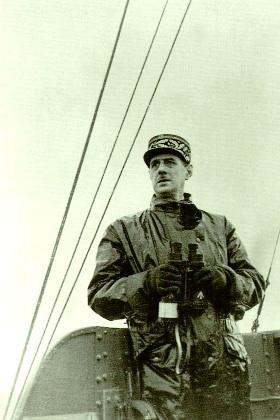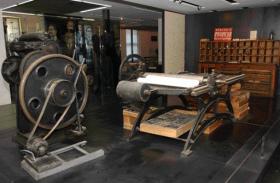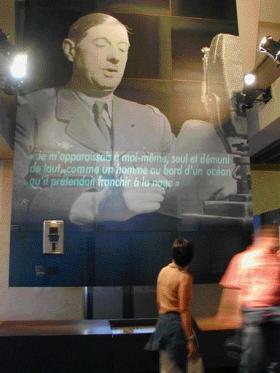Museum Eye
Published in Issue 6 (Nov/Dec 2005), Reviews, Volume 13
General de Gaulle on board La Combattante near Bayeux, 14 June 1944. (ECPA Paris)
Galleries of Charles de Gaulle
Musée de l’Armée, Hôtel des Invalides,
129 Rue de Grenelle, 75007 Paris
www.invalides.org,
10am–5pm, Oct–March, 10am–6pm, April–Sept
by Tony Canavan
In the wake of the fiftieth anniversary of the end of the Second World War the decision was taken to upgrade France’s museum of the army housed in the magnificent eighteenth-century Hôtel des Invalides under the ATHENA (Armes, Technique, Histoire, Emblématique, Nation, Armée) 2 project. The work is still going on but the first of the renovated permanent exhibitions to be opened was that on Charles de Gaulle and the Second World War, officially launched on 18 June 2000.
Having visited the old exhibition, I can say that the new one is a vast improvement. It is situated on three floors, covering 2000 square metres. The visitor begins at the top, covering the period 1939–42, and then descends through 1942–4, before finishing in the final gallery on 1944–5.
All the latest audio and visual interactive technology is employed, and even before you enter the exhibition you can hear the sounds of battle and stirring speeches. A statue of General de Gaulle greets you at the door, and indeed his presence is felt everywhere, for this is not just an exhibition about the Second World War but about France’s role in it as very much personified by de Gaulle.
All three galleries are laid out in the same way, with the rooms divided into numbered sections with themes such as the Fall of France, the Resistance, America’s Entry into the War and so on. Each section has large, well-laid-out panels with words (in French, English, German and Italian) and pictures giving a general outline of the theme that lead on to display cabinets holding artefacts and interactive touch-screens. Each floor also has a large wall-length screen running a film on the period in question (although the one on the Blitzkrieg was spoiled by being in direct sunlight). For those of us brought up in an Anglo-American milieu, it is an eye-opening experience. For example, we do not often realise the impact that the Nazi blitzkrieg had on France, when, as one panel says, ‘in 40 days nearly 100,000 men were killed and 1,800,000 taken prisoner’.
Alongside objects such as guns, rifles, radio equipment and ID cards, there is a side gallery devoted to de Gaulle, depicting his early career and explaining how he came to be leader in exile. Mementoes from the general at this period include a gold cigarette case and a silver paper knife. If the spotlight is on de Gaulle, due tribute is paid to others involved. Britain—or ‘Angleterre’, as it is referred to here—gets glowing praise for the Battle of Britain, for enduring the Blitz (one map shows Belfast as a city that was bombed) and for Winston Churchill as a wartime leader.
While the galleries have the usual paraphernalia of war, there are also some eye-catching objects. For example, the side gallery on Vichy France’s propaganda has a diorama depicting Marshal Pétain saluting the Tricolour before assembled troops. The exhibit on Free France’s desert campaign not only has life-size models of soldiers in full equipment but also a folding chair and wash basin for use by officers. Visitors should not forget to look up, as bombs dangle overhead and in one place even a V1 rocket.
In the next gallery we follow the United States’ entry into the war. Here the global aspect of the conflict is explored through displays on the war at sea, the Soviet Union and the Pacific.

Clandestine French Resistance printing press. (Musée de l’Armée–Paris)
The economic and industrial might of the USA brought with it ‘la certitude de vaincre’, we are told in one of the many quotations from de Gaulle that litter the exhibition, and is neatly illustrated by the opulent field equipment of a GI. As well as the tools of war, the American soldier also had a range of luxuries such as a razor, shaving cream, toothbrush and paste, a watch, cigarettes, pocket-sized novels and even a packet of condoms!
The side gallery on events in Russia shows that it too had a crucial role in defeating Germany, and at greater sacrifice than the USA. France, however, is not forgotten, as there is much space devoted to the Free French forces and, of course, to the Resistance, which is portrayed as a movement that embraced all sections of society, from communists and students to women and foreigners. The display on German propaganda against the Resistance, depicting its members as criminals and social misfits, has curious echoes of British propaganda against the IRA.
The final gallery brings the war to a conclusion with events such as the liberation of Paris, the fall of the Reich and so on. There is space devoted to France’s other war heroes, such as General Leclerc, ‘l’homme de Koufra’, General de Lattre, whose jeep is prominently placed at the entrance, and General Diego Brosset, whose twelve decorations are on display. However, the most striking and moving exhibits on this floor are those from the Holocaust. A map shows the location of the fourteen internment camps on French soil, and the row of badges alongside makes us realise that not just Jews but also Gypsies, homosexuals, political prisoners, ‘anti-socials’ and many others fell victim to Nazi genocide. The final part of this gallery is devoted to the atom bomb and Japan’s surrender.
De Gaulle sees us off from the exhibition in the form of a life-size photograph from 1945, emphasising again the underlying theme of France’s role in the war under his leadership. One cannot fault this exhibition’s technical brilliance or the number and type of objects on display, but some might feel uneasy or dismissive of the prominence given to France. However, due tribute is also given to her allies, particularly Britain. This is, after all, the national exhibition of France, and is the Imperial War Museum any different in depicting Britain’s role in the war? An American family and I were the only foreigners among the hundreds of visitors when I was there, for, unlike the British,

Panel depicting de Gaulle’s broadcast to the nation, 18 June 1944. (Musée de l’Armée–Paris)
the Second World War is still problematic for the French and this exhibition is one way for them to come to terms with this episode of their history. We Irish can surely identify with the final quotation from de Gaulle — ‘L’histoire n’est jamais close’.
Tony Canavan is a former Museum Officer of Newry and Mourne District Council.
















